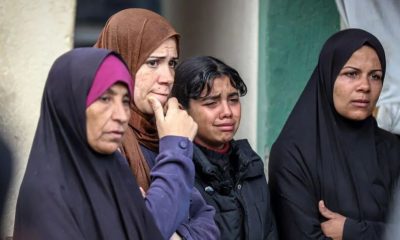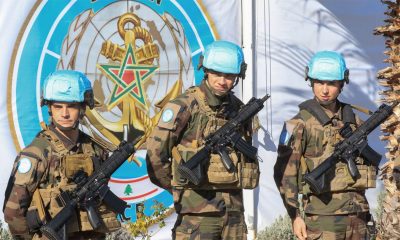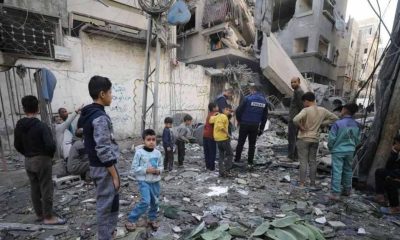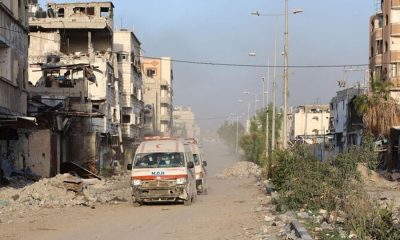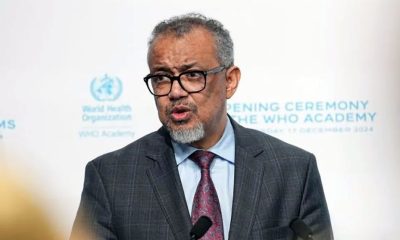International
Heavy fighting in Gaza as Israel presses ahead with renewed US military support
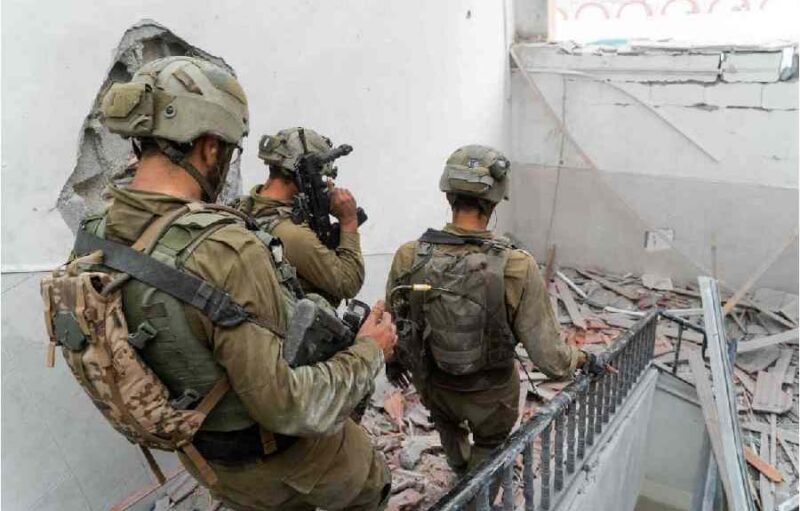
Heavy fighting in Gaza as Israel presses ahead with renewed US military support
In the midst of fierce fighting in the now-third month-old conflict, which has no end in sight, Israeli tanks encountered opposition on Monday as they attempted to advance farther west in their struggle against Hamas in and around Khan Younis.
Israel has redirected its war effort southward as seen by the fighting in Khan Younis, the biggest city in the southern Gaza Strip with a population of about 626,000, including those displaced by Israeli bombing in the north.
In recent days, the United States has once again provided crucial support to the offensive by vetoing UN Security Council attempts to halt the battle, which received widespread international support, and by forcing through an emergency sale of more than $100 million worth of tank ammunition to Israel.
U.S. President Joe Biden was commended by Israeli Prime Minister Benjamin Netanyahu for providing “important ammunition for the continuation of the war” and for standing behind Israel at the Security Council.
Amid reports of a “catastrophic” health situation in Gaza from the World Health Organization, Palestinian activists called for a global strike on Monday as part of a coordinated effort to pressure Israel into a cease-fire.
“It is time – WORLD WIDE TOTAL STRIKE,” urged one call. But it was unclear whether the effort would catch on globally or have an impact on Israel’s war plans.
The 193-member United Nations General Assembly was likely to vote on Tuesday on a draft resolution demanding a ceasefire, diplomats said on Sunday.
READ ALSO:
- FG must compensate victims of accidental airstrikes or else… – Falana
- Yoruba poet Olanrewaju Adepoju dies at 83
- Mikano Motors Celebrates Partnership with Changan Autos in Grand Style
On Friday, the United States vetoed a UN Security Council proposal demanding an immediate cease-fire for humanitarian reasons.
The U.S. vote was criticized by Arab foreign ministers on Sunday at an international conference in Doha, the capital of Qatar, which played a key role in negotiating the cease-fire late last month.
U.N. Secretary-General Antonio Guterres said he would “not give up” appealing for a ceasefire.
“I urged the Security Council to press to avert a humanitarian catastrophe and I reiterated my appeal for a humanitarian ceasefire to be declared,” Guterres said. “Regrettably, the Security Council failed to do it, but that does not make it less necessary.”
The fighting began on Oct. 7 when Hamas staged a surprise attack on Israel, killing 1,200 people and taking 240 hostages. In response, Israel has vowed to annihilate the militant Islamist group Hamas, which has ruled Gaza since 2007.
According to Gaza health authorities, around 18,000 people have been killed by Israeli attacks, with 49,500 injured. About 100 of the Israeli hostages were freed during a week-long truce that ended on Dec. 1.
On Sunday, residents of Khan Younis said tanks had reached the city’s main north-south road. Warplanes were attacking an area to the west.
READ ALSO:
- NDLEA intercepts ‘businessman’ with large consignments of cocaine at Enugu airport
- Wedding : Groom, 25 others arrested at Katsina drug party
- BREAKING : Senators donate December salaries to victims of Kaduna bombing
Guterres said the city could be on the verge of collapse with the possibility of epidemic diseases engulfing it.
Israel and Hamas meanwhile engaged in a war of words on Sunday.
Israeli Prime Minister Benjamin Netanyahu said in a televised statement that dozens of Hamas fighters had surrendered, while Hamas rebutted the claim and said it had destroyed 180 Israeli military vehicles. It did not provide evidence, however.
Meanwhile, hospitals in Gaza were at maximum capacity with dead and injured Palestinians, according to the main Nasser hospital in Khan Younis.
While the world’s attention has been riveted on the military action in the Gaza Strip, worries of the war spreading were further fed by fighting between Israel and Hezbollah in Lebanon, which is backed by Iran.
Also on Sunday, Ayman Safadi, the foreign minister of Jordan, accused Israel of “a systematic effort to empty Gaza of its people” and pushing them to leave the territory.
Israeli government spokesperson Eylon Levy called the accusation “outrageous and false,” saying his country was defending itself “from the monsters who perpetrated the Oct. 7 massacre” and bring them to justice.
Heavy fighting in Gaza as Israel presses ahead with renewed US military support
(Reuters)
International
Hamas lists 34 hostages it may free under ceasefire
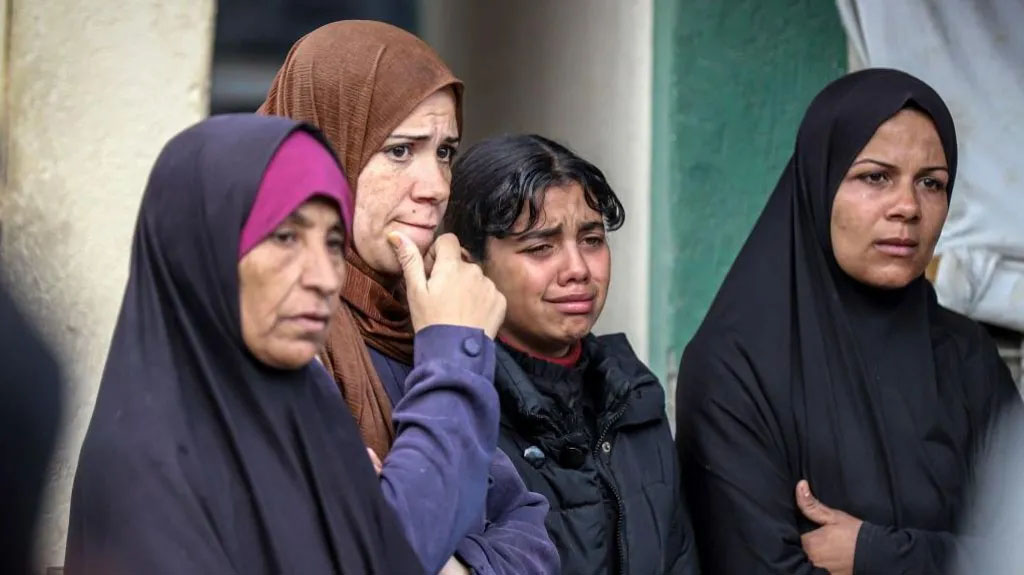
Hamas lists 34 hostages it may free under ceasefire
A senior Hamas official has shared with the BBC a list of 34 hostages that the Palestinian group says it is willing to release in the first stage of a potential ceasefire agreement with Israel.
It is unclear how many hostages remain alive.
Among those named are 10 women and 11 older male hostages aged between 50 and 85, as well as young children that Hamas previously said had been killed in an Israeli air strike.
A number of hostages that Hamas says are sick are also included on the list.
Reports from Hamas-run Gaza say Israeli air strikes killed more than 100 people there at the weekend.
The Israeli prime minister’s office denied reports that Hamas had provided Israel with a list of hostages.
Ceasefire negotiations resumed in Doha, Qatar, over the weekend, but the talks do not appear to have made significant progress yet.
READ ALSO:
- Bandits demand N10m ransom to release abducted Kogi varsity lecturer
- Farmer-herder crisis: Cooperative to establish ranches in 774 LGs
- Again, Northern elders ask FG to suspend tax reform bills
A Hamas official told Reuters news agency any agreement to return Israeli hostages would depend on a deal for Israel to withdraw from Gaza and a permanent ceasefire or end to the war.
“However, until now, the occupation continues to be obstinate over an agreement over the issues of the ceasefire and withdrawal, and has made no step forward,” the official said, speaking on condition of anonymity.
Earlier, Hamas posted a video of 19-year-old Israeli captive Liri Albag urging her government to make a deal.
She was captured along with six other female conscript soldiers at the Nahal Oz army base on the Gaza border during Hamas’s attack on 7 October 2023.
On that day Hamas-led militants attacked southern Israel, killing about 1,200 people and taking 251 others hostage.
Israel’s military campaign to destroy Hamas had killed at least 45,805 people in Gaza as of Saturday, according to the territory’s Hamas-run health ministry.
The same source says Israeli air strikes killed 88 people in Gaza on Saturday itself while on Sunday, Reuters news agency quoted health sources as saying a further 17 had died in four separate Israeli attacks on the territory.
The Israeli military said on Sunday that its air force had attacked more than 100 “terrorist” sites across the Gaza Strip over the weekend, killing dozens of Hamas militants.
Hamas lists 34 hostages it may free under ceasefire
BBC
International
China battles spike in new respiratory illness after COVID-19 pandemic

China battles spike in new respiratory illness after COVID-19 pandemic
People are once again wearing face masks as a result of a bizarre viral outbreak that is taking over several hospitals in China.
Videos of congested hospital units in China, parents waiting in lengthy lines with ailing children, and patients wearing face masks in crowded facilities have been making the rounds on social media.
Unverified reports of overcrowded crematoriums and burial homes have raised concerns and parallels to the early stages of the COVID-19 outbreak in China.
Local news outlets have attributed the outbreak to human metapneumovirus (HMPV), a virus that typically causes mild cold-like symptoms. However, Chinese health officials have not confirmed this as the cause, Dailymail reported.
The outbreak bears similarities to winter 2022/23 when mycoplasma pneumonia cases—referred to as “white lung”—spiked among children with weakened immunity due to prolonged lockdowns and school closures during the pandemic.
According to the Chinese Center for Disease Control and Prevention (CDC), the latest outbreak is largely driven by seasonal flu. Official data indicates that 30% of tests are positive for influenza, and one in seven hospitalized with severe respiratory illnesses has tested positive for the virus.
READ ALSO:
- Three Nigerian ladies in Saudi prison released after 10 months
- Burna Boy, Cubana Chief Priest feud rocks social media
- MaxAir suspends flight operations for five days
In its latest report, covering the week leading up to December 29, the Chinese CDC noted a rise in flu-like illnesses across the country. In northern provinces, 7.2% of outpatient visits were attributed to flu-like symptoms, a 12% increase from the previous week and higher than any corresponding week since 2021. In the south, 5.7% of outpatient visits were linked to flu-like illnesses, marking a 21% weekly increase, though still below 2022 and 2023 levels.
Videos showing overcrowded hospitals in Hunan province and other regions surfaced around New Year’s Eve. According to Aboluowang News, a US-based outlet covering China, a farmer in Hunan, identified as Mr. Peng, reported a surge in illnesses in his area.
‘A lot of people have caught colds, and most of them have [illness],’ he said in quotes translated to English.
‘About seven or eight people died this week in this area. Some were in their 50s, 60s, 70s, 80s and 40s.’
The news outlet also quoted a funeral director, Ms. Wang, who described long lines at her crematorium:
“There are long lines for cremation now,’ she said in translated quotes. Today, three VIP furnaces were opened.
“They were all burning and emitting a lot of smoke. It was terrible. If you don’t know about the crematorium, you would think it is selling New Year goods, just like holding a trade fair during the Chinese New Year.’
A Chinese video blogger, known as “Please Fei Ge,” shared his personal experience of falling ill after returning to their home province, which was not named, He said he and his wife both had a fever, body aches and headaches — and isolated from their children for three days to avoid transmitting the infection.
He was quoted saying: ‘This feeling is exactly the same as when I got “yang” back then. It’s very uncomfortable. If you still remember that feeling, wear a mask when you go out in crowded places.’
Last year, a surge in mysterious pneumonia cases among children led to similar viral videos showing packed hospitals in Beijing, China. At the time, Chinese authorities attributed the outbreak to a resurgence of diseases following the lifting of pandemic restrictions.
China battles spike in new respiratory illness after COVID-19 pandemic
International
UN accuses Israel of ceasefire breach
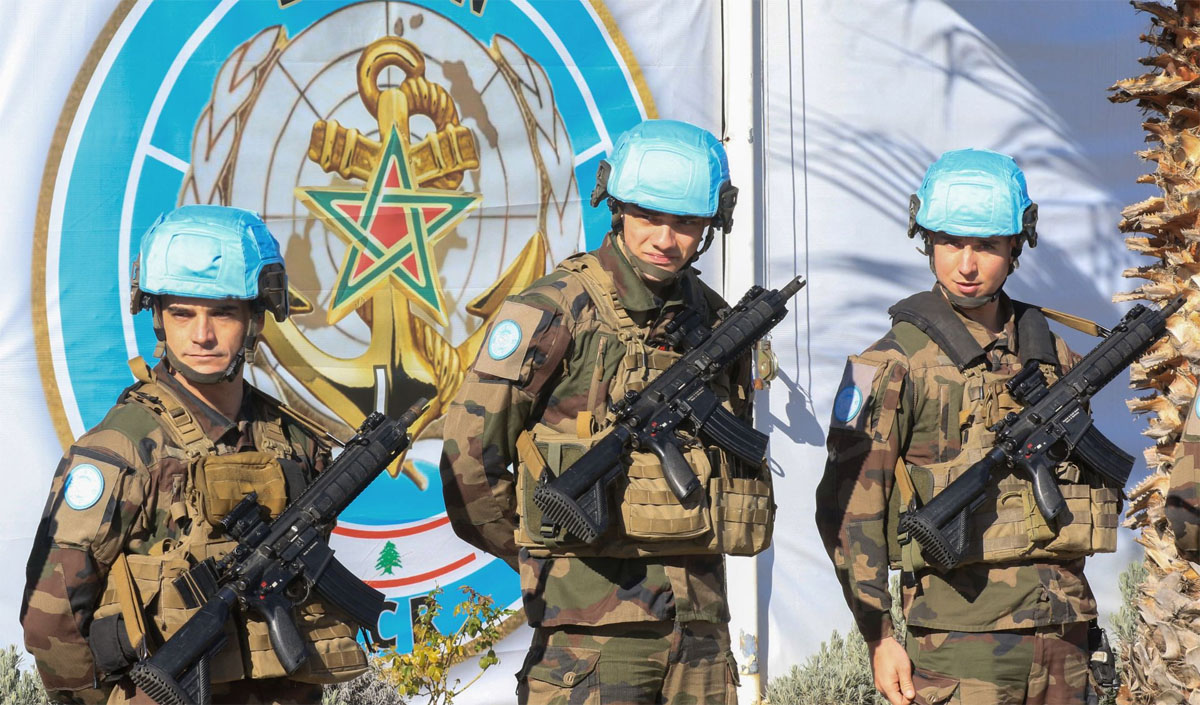
UN accuses Israel of ceasefire breach
The UN peacekeeping force in Lebanon accused Israel Saturday of a “flagrant violation” of the 2006 Security Council resolution that forms the basis of its November ceasefire with Hezbollah.
The statement from the UN Interim Force in Lebanon (UNIFIL) came as Hezbollah leader Naim Qassem warned the militant group’s patience with Israeli violations could run out before the end of the ceasefire’s 60-day implementation timeframe.
The fragile truce, which took effect on November 27, has been marked by mutual accusations of violations from both sides.
“This morning, peacekeepers observed an (Israeli military) bulldozer destroying a blue barrel marking the line of withdrawal between Lebanon and Israel in Labbouneh, as well as an observation tower belonging to the Lebanese Armed Forces immediately beside a UNIFIL position there,” the peacekeeping force said.
“The (military’s) deliberate and direct destruction of both clearly identifiable UNIFIL property and infrastructure belonging to the Lebanese Armed Forces is a flagrant violation of Resolution 1701 and international law.”
The force, which is represented on the panel overseeing the ceasefire’s implemenation, called on “all actors to avoid any actions, including the destruction of civilian property and infrastructure, that could jeopardise the cessation of hostilities”.
READ ALSO:
- Fulani herdsmen from Nigeria kill five Cameroonian soldiers, says MP
- You saved Nigeria’s democracy by defeating third term agenda, Tinubu tells Nnamani
- Air Force schools increase feeding fees by 200%
Under the terms of the ceasefire, the Lebanese army is to deploy alongside UN peacekeepers in the south as the Israeli army withdraws over a 60-day period.
Hezbollah is to withdraw its forces north of the Litani River — some 30 kilometres (20 miles) from the border — and dismantle any remaining military infrastructure in the south.
In late December, the UN peacekeeping force expressed concern at the “continuing” damage being done by the Israeli military in south Lebanon.
Detailing its latest air strikes in Lebanon on Thursday, the Israeli military said it was acting to remove any threat to Israel “in accordance with the ceasefire understandings”.
Qassem said Hezbollah had decided to show patience, but warned that would not last indefintely.
UN accuses Israel of ceasefire breach
-

 Business2 days ago
Business2 days agoMeta deletes AI accounts after backlash over posts
-

 Business2 days ago
Business2 days agoPetrol price may crash to N500/litre, say marketers
-

 metro2 days ago
metro2 days agoYouths beat Osun monarch for appointing Imam
-

 metro3 days ago
metro3 days agoMosques should be research centres – Varsity don
-

 Entertainment2 days ago
Entertainment2 days agoKano suspends Kannywood actress over indecent dressing, provocative content
-

 metro2 days ago
metro2 days agoYar’Adua stopped refinery sale to Dangote over due process, paltry amount – Falana replies Obasanjo
-

 metro3 days ago
metro3 days agoEdo LG chairman, 8 councillors, defect to APC
-

 metro3 days ago
metro3 days agoDrunk police officer ‘frees’ 13 suspects to celebrate new year

